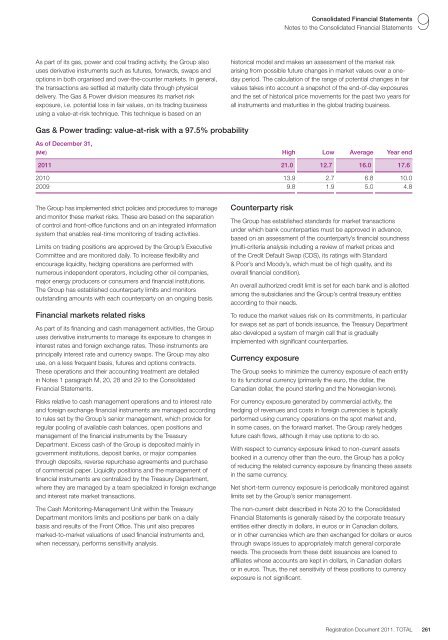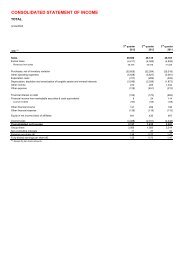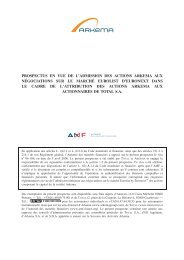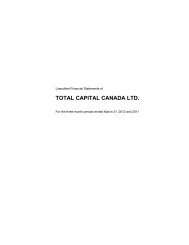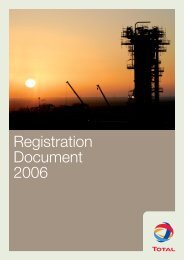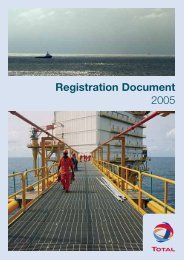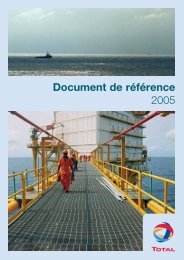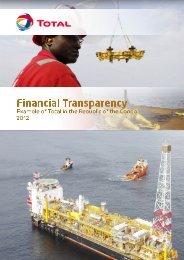Registration document 2011 - tota - Total.com
Registration document 2011 - tota - Total.com
Registration document 2011 - tota - Total.com
Create successful ePaper yourself
Turn your PDF publications into a flip-book with our unique Google optimized e-Paper software.
As part of its gas, power and coal trading activity, the Group also<br />
uses derivative instruments such as futures, forwards, swaps and<br />
options in both organised and over-the-counter markets. In general,<br />
the transactions are settled at maturity date through physical<br />
delivery. The Gas & Power division measures its market risk<br />
exposure, i.e. potential loss in fair values, on its trading business<br />
using a value-at-risk technique. This technique is based on an<br />
Gas & Power trading: value-at-risk with a 97.5% probability<br />
The Group has implemented strict policies and procedures to manage<br />
and monitor these market risks. These are based on the separation<br />
of control and front-office functions and on an integrated information<br />
system that enables real-time monitoring of trading activities.<br />
Limits on trading positions are approved by the Group’s Executive<br />
Committee and are monitored daily. To increase flexibility and<br />
encourage liquidity, hedging operations are performed with<br />
numerous independent operators, including other oil <strong>com</strong>panies,<br />
major energy producers or consumers and financial institutions.<br />
The Group has established counterparty limits and monitors<br />
outstanding amounts with each counterparty on an ongoing basis.<br />
Financial markets related risks<br />
As part of its financing and cash management activities, the Group<br />
uses derivative instruments to manage its exposure to changes in<br />
interest rates and foreign exchange rates. These instruments are<br />
principally interest rate and currency swaps. The Group may also<br />
use, on a less frequent basis, futures and options contracts.<br />
These operations and their accounting treatment are detailed<br />
in Notes 1 paragraph M, 20, 28 and 29 to the Consolidated<br />
Financial Statements.<br />
Risks relative to cash management operations and to interest rate<br />
and foreign exchange financial instruments are managed according<br />
to rules set by the Group’s senior management, which provide for<br />
regular pooling of available cash balances, open positions and<br />
management of the financial instruments by the Treasury<br />
Department. Excess cash of the Group is deposited mainly in<br />
government institutions, deposit banks, or major <strong>com</strong>panies<br />
through deposits, reverse repurchase agreements and purchase<br />
of <strong>com</strong>mercial paper. Liquidity positions and the management of<br />
financial instruments are centralized by the Treasury Department,<br />
where they are managed by a team specialized in foreign exchange<br />
and interest rate market transactions.<br />
The Cash Monitoring-Management Unit within the Treasury<br />
Department monitors limits and positions per bank on a daily<br />
basis and results of the Front Office. This unit also prepares<br />
marked-to-market valuations of used financial instruments and,<br />
when necessary, performs sensitivity analysis.<br />
Counterparty risk<br />
The Group has established standards for market transactions<br />
under which bank counterparties must be approved in advance,<br />
based on an assessment of the counterparty’s financial soundness<br />
(multi-criteria analysis including a review of market prices and<br />
of the Credit Default Swap (CDS), its ratings with Standard<br />
& Poor’s and Moody’s, which must be of high quality, and its<br />
overall financial condition).<br />
An overall authorized credit limit is set for each bank and is allotted<br />
among the subsidiaries and the Group’s central treasury entities<br />
according to their needs.<br />
To reduce the market values risk on its <strong>com</strong>mitments, in particular<br />
for swaps set as part of bonds issuance, the Treasury Department<br />
also developed a system of margin call that is gradually<br />
implemented with significant counterparties.<br />
Currency exposure<br />
Consolidated Financial Statements 9<br />
Notes to the Consolidated Financial Statements<br />
historical model and makes an assessment of the market risk<br />
arising from possible future changes in market values over a oneday<br />
period. The calculation of the range of potential changes in fair<br />
values takes into account a snapshot of the end-of-day exposures<br />
and the set of historical price movements for the past two years for<br />
all instruments and maturities in the global trading business.<br />
As of December 31,<br />
(M€) High Low Average Year end<br />
<strong>2011</strong> 21.0 12.7 16.0 17.6<br />
2010 13.9 2.7 6.8 10.0<br />
2009 9.8 1.9 5.0 4.8<br />
The Group seeks to minimize the currency exposure of each entity<br />
to its functional currency (primarily the euro, the dollar, the<br />
Canadian dollar, the pound sterling and the Norwegian krone).<br />
For currency exposure generated by <strong>com</strong>mercial activity, the<br />
hedging of revenues and costs in foreign currencies is typically<br />
performed using currency operations on the spot market and,<br />
in some cases, on the forward market. The Group rarely hedges<br />
future cash flows, although it may use options to do so.<br />
With respect to currency exposure linked to non-current assets<br />
booked in a currency other than the euro, the Group has a policy<br />
of reducing the related currency exposure by financing these assets<br />
in the same currency.<br />
Net short-term currency exposure is periodically monitored against<br />
limits set by the Group’s senior management.<br />
The non-current debt described in Note 20 to the Consolidated<br />
Financial Statements is generally raised by the corporate treasury<br />
entities either directly in dollars, in euros or in Canadian dollars,<br />
or in other currencies which are then exchanged for dollars or euros<br />
through swaps issues to appropriately match general corporate<br />
needs. The proceeds from these debt issuances are loaned to<br />
affiliates whose accounts are kept in dollars, in Canadian dollars<br />
or in euros. Thus, the net sensitivity of these positions to currency<br />
exposure is not significant.<br />
<strong>Registration</strong> Document <strong>2011</strong>. TOTAL<br />
261


